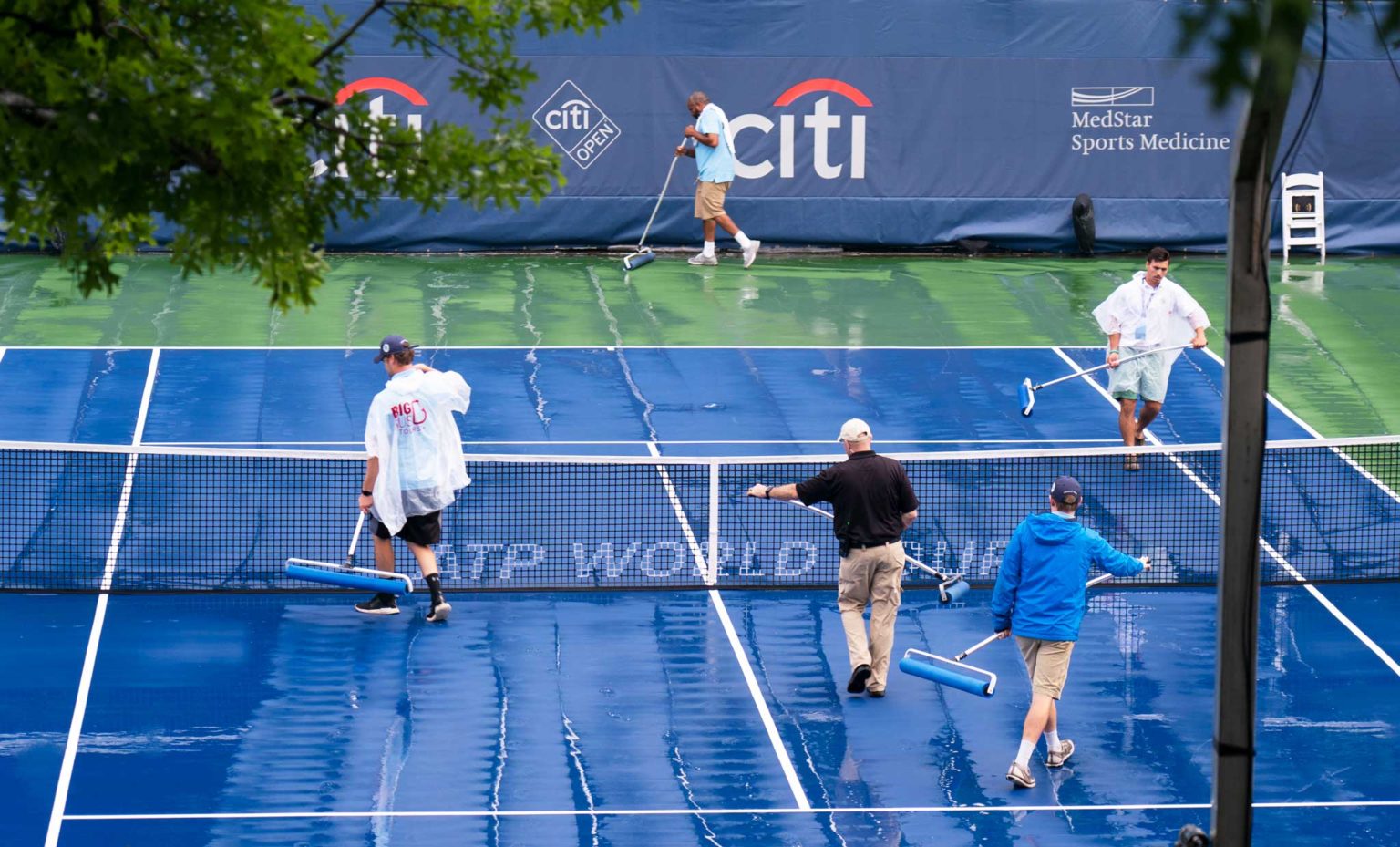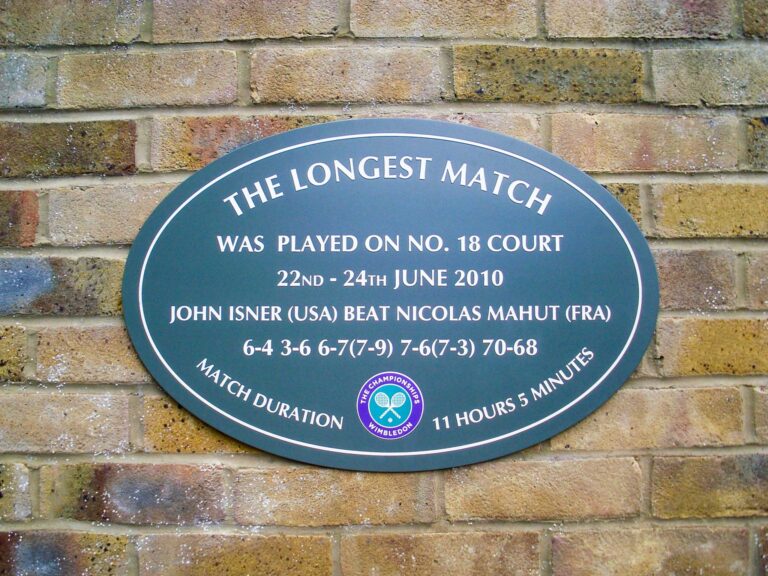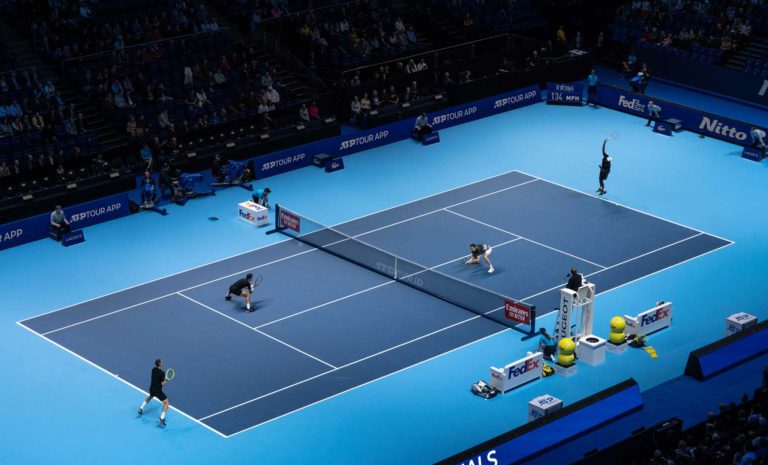For many tennis players, particularly those of us based in the UK, playing tennis in the rain is a common occurrence. Some players become accustomed to playing in cold and wet conditions and learn to thrive during the winter tennis leagues. However, most players feel insecure on a wet tennis court, can’t seem to find any rhythm and simply hate playing tennis on a rainy night. Not to worry though, as in this article we’ll be explaining everything you need to know about playing tennis in the rain, including how to do it safely and how to adapt your game and beat your opponent.
Can you Play Tennis in the Rain?
Yes, you can absolutely play tennis in the rain. That being said, it very much depends on you and how comfortable you are moving on wet courts, as well as things like how heavy the rain is and the type of tennis court you are playing on. It’s great and all when someone else says the courts are fine to play on, but if you aren’t comfortable, don’t risk it. Particularly when playing on wet courts, any slip can lead to a pretty severe injury that could leave you sidelined for a few months. If in doubt, exercise caution and maybe decide to give it a miss.
Can you play tennis on wet tennis courts?
Sure you can, but there’s always a risk. Once again, it depends on you and the tennis court surface you are playing on. Some tennis court surfaces are much more playable in wet conditions, while others can be completely unplayable and make you fell like you’re walking on ice.
- Astro-turf and similar tennis surfaces are often considered all weather courts. Generally, they are playable almost as soon as the rain has stopped. If it was a rather heavy downpour, the courts may take half an hour to drain, but should be fine to play on after that.
- Hard courts are somewhat similar. They are a little more difficult to play on when wet, though they tens to drain and dry off pretty quickly, specially if the sun comes out.
- Clay tennis courts are meant to be slightly wet when played on, so they should be fine to play on in the rain. Unless it rains extremely heavily, the clay can soak up a lot of the water and the court will still be playable. If it rains too much though, playing on them can often damage the courts quite badly, so your club may encourage you to give it a rest that day.
- Natural grass becomes extremely slippery when wet. Even the pros, with their fantastic on-court movement, struggle to play on wet grass courts. Personally, it would be a no-go for me.

Be extremely careful when playing on half wet courts. This is probably when a tennis court is most dangerous. It seems a little counter intuitive, but half-wet courts are often the most difficult to play on. This is because you will naturally adjust to playing on wet or dry courts, but rarely be prepared for a sudden wet patch on a dry court. If you like to slide on wet courts, hitting a sudden dry patch means your shoes will suddenly grip to the court, and can often lead to falling over and even worse, twisting an ankle.
And be sure to watch out for the slippery lines. On pretty much any wet tennis court, the most slippery and dangerous part of the court will be the lines. Not much can be done to avoid them, just try to keep them in mid if trying to slide across the court or when running along the baseline.
How to avoid injuries when playing tennis in the rain
Before you start playing tennis in the rain or on wet courts, there are a few things you should keep in mind to reduce your chances of injury…
- Keep warm. Getting cold can often lead to injury, whether it’s catching a common cold, stiffening up and pulling a muscle or causing an even worse injury when you eventually slip. Make sure to keep warm, ideally by wearing a jacket at all times, even if you don’t feel cold.
- Stay hydrated. The risk of a tennis injury is always higher when a player is dehydrated. When it’s hot, we’re usually reaching for our water bottle, but when it’s cold and rainy, we almost forget to drink water. Be sure to grab a drink at each change of ends, even if it’s just a little bit.
- Wear shoes with good grip. This means no severely worn out shoes, but also means no brand new shoes. Shoes that haven’t been broken in can have just as little grip as the worn out ones. They can also have too much grip, believe it or not. Brand new shoes can often hinder your movement and not allow you to slide on wet courts. Ideally, wear your regular tennis shoes that you’ve been wearing for a while. And of course, make sure they are tennis shoes. Leave your running shoes at home for this one!
- Keep your racquet dry. Playing tennis with a racquet with a wet grip can often lead to blisters. Be sure to wipe your grip down with a towel at the change of ends.
Tips for playing tennis in the rain
Now that you know how to stay safe when playing tennis in the rain or on wet tennis courts, lets talk a bit about the strategies you should be using to beat your opponent:
- Bend your knees. This may sound a little obvious, but the first thing we forget when playing on wet courts is that the ball bounce is much lower. Remember to get down to the ball by bending your knees.
- Adapt your swing. If you’re playing on astro-turf courts, shorten your swing to account for the ball skidding through the court and making rallies much quicker. If you’re playing on clay courts and the ball is much heavier, try to make your swing a little bigger, giving you the chance to generate a bit more power and increase your chances of hitting winners.
- Shorten the points. Specially when the balls get a little heavier and moving around on the court is a little more difficult, look to shorten the points. Try to play more aggressive tennis, before you give your opponent the chance to do the same. Get to the net and volley as much as you can.
- Make your opponent move. Not just side to side, but back and forth too. On wet courts where movement is a lot more limited, the drop shot is one of the most effective shots you can play.
- Use slice spins more than topspin. It will probably come as no surprise that topspin shots just don’t bounce as high as they normally would, both because of the wet courts and the heavier balls. Instead, try to make use of slice shots, both on groundstrokes and on your serve too. Chipping the ball back keeps the ball real low and won’t allow your opponent to attack. Ditching your kick serve in favour of
- Learn to slide. When playing on wet courts, you won’t get a lot of grip with your shoes, making footwork all the more important. Learning how to slide on a tennis court will make you a lot more comfortable playing on wet courts and can open up a whole new level of tennis. This is also a skill you can use when playing on clay courts and sometimes even natural grass courts.
As a general tip, avoid using new tennis balls in the rain, unless you’re playing a tournament or league match where it’s a requirement. Even if it has already stopped raining and you’re just playing on wet courts, the balls will no doubt be ruined after a couple of sets, whether they start out as new or once used. Either way, you’ll be chucking them out once you’re finished.
You may also want to consider wearing a baseball cap which will help keep the rain out of your eyes, specially when serving.
Hopefully, all these tips will help you become much more comfortable moving around on wet tennis courts, and help you thrive when playing in your winter league matches which so often have us playing on cold and rainy nights. If you have any other tips for playing tennis in the rain or you think we’ve missed one, be sure to let us know in the comments.




